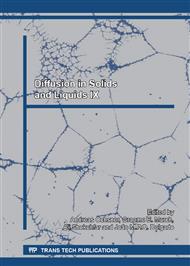[1]
W.D. Callister, Jr. and D.G. Rethwisch. Fundamentals of materials science and engineering: an integrated approach. 3rd. ed. John Wiley & Sons, Inc. USA (2008).
Google Scholar
[2]
W. D. Callister, Jr. Materials science and engineering. an introduction. 7rd ed., John Wiley & Sons, Inc. USA (2007).
Google Scholar
[3]
D.A. Brosnan and G.C. Robinson. Introduction of drying of ceramics: with laboratory exercises. The American Ceramic Society Westerville (2003).
Google Scholar
[4]
M. Hasatani and Y. Itaya: Drying'96. Vol. A (1996), p.27.
Google Scholar
[5]
Y. Itaya and M. Hasatani: Drying Technol. Vol. 14, 6, (1996), p.1301.
Google Scholar
[6]
J.S. Reed: Principles of ceramics processing, John Wiley & Sons, Inc., New York (1995).
Google Scholar
[7]
A. Sander, D. Skanki and B. Nenad: Ceramics Int. Vol. 29 (2003) p.641.
Google Scholar
[8]
A.A.J. Ketelaars, W. Jomaa, J.R. Puiggali and W.J. Coumans: Drying'92. Vol. A (1992) p.293.
Google Scholar
[9]
A.J.J. van der Zanden, A.M.E. Schoenmakers, and P.J.A.M. Kerkof: Drying Technol. Vol. 14, 3-4 (1996) p.647.
Google Scholar
[10]
S. Su: Applied Clay Sci. Vol 12 (1997) p.189.
Google Scholar
[11]
van der Zanden, A. J. J. Modelling and simulating simultaneous liquid and vapour transport in partially saturated porous materials, in: Mathematical Modeling and Numerical Techniques in Drying Technology, New York: Marcel Dekker, Inc., 1997.
Google Scholar
[12]
Y. Itaya, S. Taniguchi and M. Hasatani: Drying Technol. Vol 15, 1 (1997), p.1.
Google Scholar
[13]
Y. Itaya, S. Mori and M. Hasatani, in: Drying'98. Vol. A (1998) p.240.
Google Scholar
[14]
W. P. Silva, V. S. O. Farias, G. A. Neves and A.G.B. Lima: Heat Mass Transf. Vol. 48, 5 (2012) p.809
Google Scholar
[15]
F. Augier, W.J. Coumans, A. Hugget and E.F. Kaasschieter: Chem. Eng. J. Vol. 86 (2002) p.133.
Google Scholar
[16]
J. J. S. Nascimento, A. G. B. Lima, B. J. Teruel and F. A. Belo: Información Tecnológica Vol. 17, 6 (2006) p.125. (In spanish).
Google Scholar
[17]
J. B. Silva, G. S. Almeida, G.A. Neves, W.C.P. B. Lima, S.R. Farias Neto and A.G. B. Lima: Def. Diff. Forum Vols. 326-328 (2012) p.267.
Google Scholar
[18]
J.B. Silva, PhD. Thesis, Process Engineering, Federal University of Campina Grande, Campina Grande, Brazil (2009) (In Portuguese)
DOI: 10.21475/ajcs.2016.10.10.p7455
Google Scholar
[19]
J.B. Silva, G.S. Almeida, W.C.P. B. de Lima, G.A. Neves, A.G.B. de Lima: Def. Diff. Forum. Vols. 312-315 (2011) p.971.
Google Scholar


